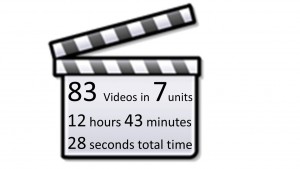Dr. Mine Çetinkaya-Rundel’s Statistics 101 course, “Data Analysis and Statistical Inference,” began at Duke, spread throughout the world via Coursera (a MOOC provider) and is now finding more ways to reach students at Duke and beyond.
Dr. Çetinkaya-Rundel taught “Data Analysis and Statistical Inference” to Duke undergraduates for several years before developing her teaching materials into an online Coursera course. The standards for the online course, massive audience and deadlines motivated her to create and complete comprehensive learning objectives, polished videos and assessments that were greatly appreciated by students across the world. Now, the materials from the MOOC have come back to campus, where they are having multiple impacts.
The learning materials
The materials developed for the Coursera course include:
- A complete set of learning objectives for each course unit, mapped to readings and “test yourself” questions.
- Lecture videos with downloadable slides and questions to check student understanding throughout the videos.
- Suggested exercises for each unit.
- Links to an online textbook and extensive supplementary resources including videos, tutorials, blogs, and web tools.
Campus Impact: Face-to-face, for-credit courses at Duke
In Fall 2014 and Spring 2015, the two sections of Duke’s on-campus “Data Analysis and Statistical Inference” course each enrolled over 100 students. One section was taught by Dr. Çetinkaya-Rundel and the other by Dr. Jesse Windle. Each instructor assigned materials in the Coursera course to help students prepare for their face-to- face course.
Dr. Çetinkaya-Rundel assigned the online course material to her students to help them learn basic content so they could apply it during her flipped class. Students are given the learning objectives and can use the text or video to meet these objectives. Explicit learning objectives help students focus on what they need to learn, so they don’t get lost in the videos. In addition, there are questions both within the videos and in the learning objectives so that students can test their own comprehension before they come to class.
She found that her students reacted more favorably to preparing for her flipped class using videos than in previous years when she flipped her course using only the text. The content available for her students in Coursera has allowed her to spend more time helping her students apply the content in class. She thinks that delivering the course content online has increased student engagement during class as they work on applying the materials together, and students are spending more time studying outside of class.
Some comments from her students:
This class has been extremely helpful and is an excellent example of how a flipped classroom should work. I enjoy the balance of in-class lecture material and applications. The videos outside of class also really address how I learn and have reinforced the material immensely.
Professor Cetinkaya-Rundel does an amazing job teaching the class. Clickers are a unique way to engage students and to make lectures interesting. The videos, though at times a bit repetitive, are thorough and very helpful. The professor’s willingness to gather new data sets and incorporate real-world events into lectures is much appreciated– the associations help make the material much more interesting. I was very worried about getting through this class, but I literally do not think the subject could be taught any better than Professor Cetinkaya-Rundel teaches it.
I just like the idea of the group and the videos because I feel like it helped a lot, especially in explaining difficult concepts. I also like the idea of using the clicker and doing the application question in class because I think it’s a better way for me to learn about the information and retain it in my head by putting it into practice.
She noted that it is very time consuming to make good videos, and credited her work with Coursera with motivating her to complete high quality videos.
In Dr. Windle’s Fall 2014 Statistics 101 course, materials from the Coursera course supplemented his lectures. He complemented the vid eo examples with examples of his own, to help students apply the course content to different data sets and case studies. He also used clickers in class to check on student comprehension. He is grateful to be able to share the videos with his students to help them learn Statistics.
eo examples with examples of his own, to help students apply the course content to different data sets and case studies. He also used clickers in class to check on student comprehension. He is grateful to be able to share the videos with his students to help them learn Statistics.
In his Spring 2015 course, he used the materials to incorporate more active learning in his face to face class. This spring, he has placed more emphasis on in-class exercises and group work to align his course more closely with Dr. Çetinkaya-Rundel’s. He agrees that flipping the class leads to a more engaged audience but warns that it also requires a lot of work, noting that the course he is teaching this semester would be infeasible without the help of Dr. Çetinkaya-Rundel and her materials.
Campus Impact: Duke for-credit, summer online course
Dr. Çetinkaya-Rundel uses her Coursera material to teach a hybrid synchronous online course during the summer for Duke students. Students prepare for their online meetings using the Coursera materials, then apply the concepts when they talk with each other during their online meetings.
Campus Impact: Interdisciplinary research project
 Dr. Çetinkaya-Rundel has teamed up with Dr. Dorian Canelas and several Duke students on a Bass Connections Project, a new university-wide initiative that links faculty and students to respond to complex challenges through problem-focused educational pathways and project teams. Their team “Coursera and the Future of MOOCs” investigates alternative means of conveying information and probes the future of online education through mixed-methods research, examining characteristics and behavior of the participants in the Coursera course.
Dr. Çetinkaya-Rundel has teamed up with Dr. Dorian Canelas and several Duke students on a Bass Connections Project, a new university-wide initiative that links faculty and students to respond to complex challenges through problem-focused educational pathways and project teams. Their team “Coursera and the Future of MOOCs” investigates alternative means of conveying information and probes the future of online education through mixed-methods research, examining characteristics and behavior of the participants in the Coursera course.
Campus Impact: Duke Continuing Studies online course
Duke Continuing Studies is using the MOOC materials to offer an online course, “Data, Statistical Inference, and Modeling” for professionals who need to understand and analyze data. The course is available as either a full 10-week course supplemented by a private learning community or as several independent, short modules. Successful students can earn a noncredit Certificate of Completion from Duke University Continuing Studies with Continuing Education Units (CEUs). This continuing studies course also contributes to graduate education, as the student teaching assistant is a Bass Online Apprentice fellow developing skills for online teaching.
 Bonus Impact: Courses across the world
Bonus Impact: Courses across the world
Dr. Çetinkaya-Rundel has received many inquiries about using her course material to supplement other courses, from individuals in organizations ranging from a Russian law school to Dell employee training as well as faculty at various high schools and higher education institutions.
The impact of this Massive Open Online Course continues to ripple both within and outside of Duke! The next offering of Coursera’s “Data Analysis and Statistical Inference” starts in March. Join the fun!
